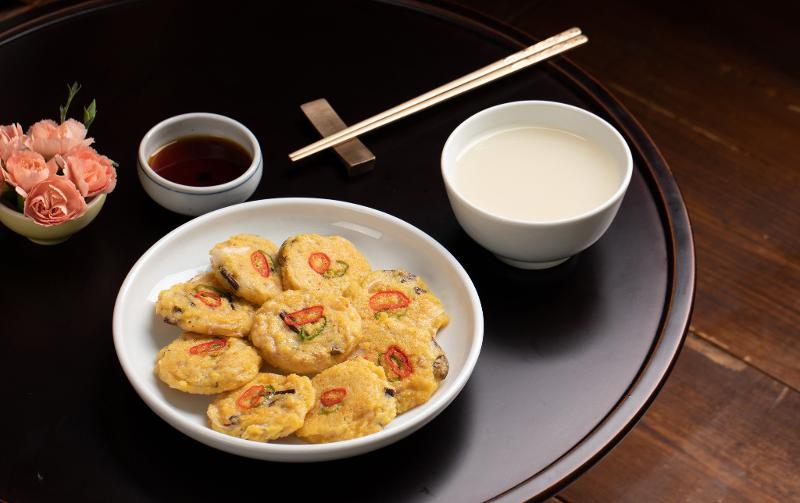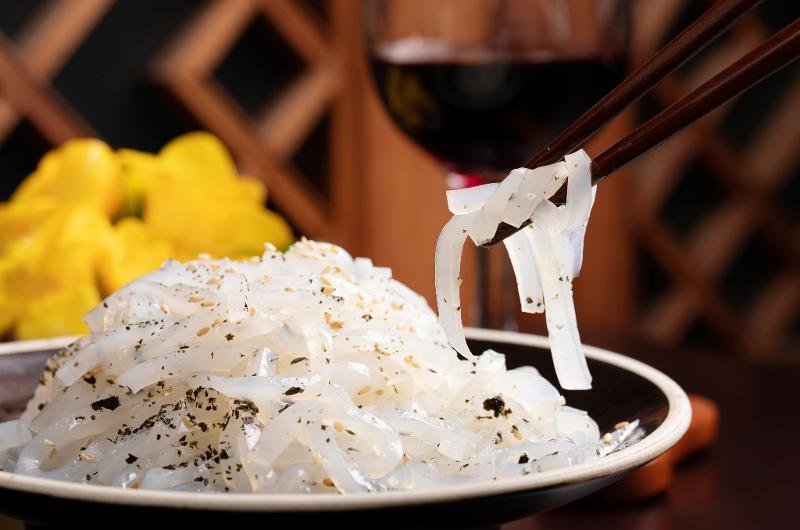

Yoon Sook-ja, director of the Institute of Traditional Korean Food, recommends pairing nokdujeon (pancakes made with mung bean, pork and kimchi) with makgeolli (milky rice wine). She said the savory taste of nokdu (mung bean) and the combination of kimchi, pork, bean sprouts and fern bracken go well with the wine, adding that the pancakes are full of essential amino and unsaturated fatty acids that help digestion and detoxification of waste.
By Yoon Sojung with contribution from Kim Yeonsue
Photos = Kim Sunjoo
Collaborator: Institute of Traditional Korean Food
Yoon Sook-ja, director of the Institute of Traditional Korean Food in Seoul, says Korean alcoholic drinks are tastier when paired with Korean dishes.
Dubbed an “ambassador of Korean food,” she is widely known for promoting Hansik (Korean food) worldwide.
Based on her recommendations, Korea.net in a two-part series presents food pairings that make the most popular kinds of booze in Korea — makgeolli (milky rice wine), soju (clear liquor), beer and fruit wine — more enjoyable.
The suggested foods have nutritional value and create a good harmony with the characteristics of each beverage. Yoon said the dishes help people enjoy the drinks and protect health at the same time in line with the Korean proverb “The roots of medicine and food are the same.”
Vegetarians or vegans can also enjoy such foods by substituting one or two ingredients.
[Makgeolli and nokdujeon]
Yoon recommended nokdujeon, or pancakes made of mung bean, pork and kimchi, to go with makgeolli, which is considered the leading alcoholic drink of laypeople in Korea.
The traditional round pancakes are made by grinding nokdu (mung beans) soaked in water on a millstone, adding fern bracken, pork and kimchi, and frying it in oil. Originally from India, the mung bean is an annual plant grown widely across Asia. In Korea, it is used to make bindaetteok (mung bean pancakes), cheongpomuk (mung bean jelly) and nokdujuk (mung bean porridge), and its bean sprout sukju is also widely in Korean cuisine.
“This dish harmonizes the savory taste of nokdu with kimchi, pork, bean sprouts and fern bracken, and is rich in essential amino and unsaturated fatty acids that helps digestion and detoxification of waste products in the body,” Yoon said.
When nokdujeon is eaten with makgeolli, this combination neutralizes alcoholic poisoning and protects internal organs. The savory and light taste of the pancakes also creates harmony with the sweet and tangy refreshing taste of the wine.
The Donguibogam (Principles and Practice of Eastern Medicine), the leading medical textbook of the Joseon Dynasty era, describes nokdu as “cold, sweet and non-toxic” with the effects of detoxifying all poison and treating skin disease. The book also said mung beans reduce fever, quench thirst, harmonize internal organs and relax the mind.
If nokdu is unavailable, pajeon (green onion pancakes) are a good substitute. “Pajeon is also a popular food that goes well with makgeolli,” Yoon said, “This was also more popular among laypeople than nokdujeon.”
In Korea, especially on cloudy or rainy days, many people seek pajeon and numerous stories explain this.
“Some say it’s because the sound of raindrops is similar to that of frying jeon with oil,” Yoon said. “Others say it’s because high humidity on a rainy day more effectively spreads the fragrant smell of jeon and stimulates the sense of smell.”
[Bokbunjaju and Gaeseong-style muk muchim]

Gaeseong-style muk muchim (jelly salad) is characterized by its light and clean texture and savory taste. When served with fruit wine, the dish creates harmony inside the palate while retaining the taste of the wine.
Bokbunjaju (raspberry wine) is a popular fruit wine in Korea characterized by its deep purple color, strong aroma and sweet taste.
Korean fruit wines, which are mostly made from raspberries or plums, pair well with dishes with less stimulating flavor, Yoon said, adding that because such wines have a strong taste, aroma and individuality, their taste can get buried by foods with a strong taste.
The director recommended Gaeseong-style muk muchim (mung bean jelly salad) to eat with bokbunjaju.
Mung beans are also used in Gaeseong-style muk muchim, which is named after a city in North Korea near the inter-Korean border that was the capital of the Goryeo Dynasty (918-1392). This style of the jelly salad is made by finely chopping cheongpomuk made with mung beans, seasoning with salt and sesame oil, and adding seaweed flakes and sesame powder.
Muk muchim is characterized by its clean and light taste and soft texture that produces delicious flavor when combined with fragrant sesame oil and flakes. When bokbunjaju, with its rich aroma and sweet taste, is served with this dish, neither the wine nor food erases the other’s taste but instead forms a harmony of flavor in the mouth.
arete@korea.kr























